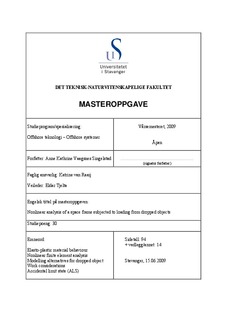| dc.contributor.author | Singelstad, Anne Kathrine Vaagsnes | |
| dc.date.accessioned | 2009-11-26T07:59:25Z | |
| dc.date.issued | 2009 | |
| dc.identifier.uri | http://hdl.handle.net/11250/182655 | |
| dc.description | Master's thesis in Offshore structural engineering | en |
| dc.description.abstract | There is always a risk of an object being dropped during offshore lifting operations. Any underlying structure or equipment might be severely damaged, and in worst case, lives might be lost. Consequently, structures which might be subjected to an accidental event with an annual probability of 10-4 are required to be designed in accidental limit state (ALS). Design in ALS often requires for the structural response to be taken into the plastic range, which means that nonlinear analysis methods must used.
This master thesis deals with nonlinear structural response. For one specific case, results from hand calculations are compared to results obtained from nonlinear finite element analysis and evaluated as to give an indication of the usefulness of simplified methods to predict nonlinear structural response for the specific structure. The second objective of this master thesis is to compare two different ways of modelling a dropped object scenario in a finite element analysis program. The first, method 1, includes a model of the dropped object where a hyperelastic spring element is introduced to establish contact between the falling object and the underlying structure. In method 2, the node representing the point of impact is given an initial velocity equal to the velocity at impact for the same load scenario as in method 1. The case used for the hand calculations and the nonlinear finite element analyses is a space frame subjected to impact loading from a 6000 kg container dropped from a height of 3 m. The space frame will therefore be analyzed in the accidental limit state (ALS).
The nonlinear (dynamic) analyses have been carried out using the nonlinear finite element software USFOS. The model of the space frame was converted from the structural design and analysis program StaadPro.
It proved difficult to account for the selfweight and live load in work considerations since the dropped object loading is given as energy and the other two as (static) uniformly distributed loads. For a correct evaluation of the suitability of hand calculations the effect of selfweight and live load must be taken into account in the calculations.
Method 1 is, of the methods considered herein, the method which physically simulates a real dropped object scenario most correctly. Modelling alternative No. 2 gave larger maximum displacement than method 1, and results indicate that the actual amount of energy impacting the structure becomes larger for method 2 than for method 1. A possible improvement of method 2 has been suggested in the conclusion. | en |
| dc.format.extent | 1090041 bytes | |
| dc.format.mimetype | application/pdf | |
| dc.language.iso | eng | en |
| dc.publisher | University of Stavanger, Norway | en |
| dc.relation.ispartofseries | Masteroppgave/UIS-TN-IKM/2009 | en |
| dc.subject | offshore teknologi | en |
| dc.subject | konstruksjonsteknikk | en |
| dc.subject | elasto-plastic material behaviour | en |
| dc.subject | nonlinear finite element analysis | en |
| dc.subject | modelling alternatives for dropped object | en |
| dc.subject | work considerations | en |
| dc.subject | accidental limit state (ALS) | en |
| dc.title | Nonlinear analysis of a space frame subjected to loading from dropped objects | en |
| dc.type | Master thesis | en |
| dc.subject.nsi | VDP::Technology: 500::Marine technology: 580::Offshore technology: 581 | en |
